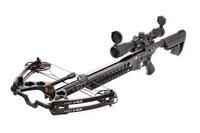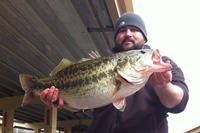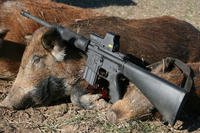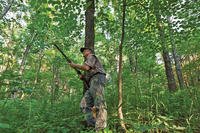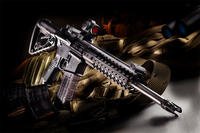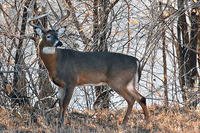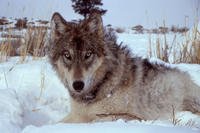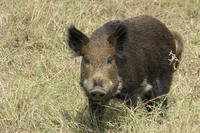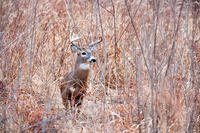There are four critters considered predators in my part of the country — coyote, bobcat, fox and raccoon.
by Emory Josey
There are four critters considered predators in my part of the country — coyote, bobcat, fox and raccoon. There's always someone (I'm not one of them), wanting 'coon for table fare. Coyotes are classified as vermin that ought to be killed and discreetly disposed of. Fox called to the gun are shot by some. Most of my hunting buddies and I have elected to enjoy the show when Renyard displays his courage coming to the call, but we generally don't drop the hammer on him. We give him a pass because coyotes have thinned our fox to the point they're only a faint shadow of the population we had 20 years ago. The survivors learned that answering a screaming rabbit call could mean being eaten by Wiley. During the 70s and 80s, my sighting-to-setup ratio for fox was one out of three. These days, one-to-20 is a good average. As for the red fox, I have called less than a dozen in five years. Coyotes have devastated them.
The bobcat is considered the real trophy in the East, and most hunters long for a mounted bobcat. I am in awe of this magnificent feline. As a kid, I quickly passed up other predators in the zoo to observe the bobcat. The beautiful muscular body, fluid motion and stalking abilities fascinate me. As opposed to the ugly coyote, I even find a bobcat's face attractive. I get excited when a coyote or fox answers my call, but ecstatic when a cat responds.
Where To Find Them
If I make half a dozen setups during a day of calling coyotes, I am reasonably sure at least one dog will hear my call, even if I don't see it. I'm never sure a bobcat hears my call. Bobcats require a larger base territory than other predators. There just aren't as many Eastern bobcats per square mile as there are coyotes. Eastern cats prefer swamps, dense forests and rock outcroppings. While bobcats would rather stay dry, they are usually on patrol around water sources, especially creeks that never dry up. Such terrain harbors the prey they need for food.
Felines eat carrion if forced to, but they prefer live prey. They will cover over a kill with leaves after they have eaten, and will return to it only if they can't find fresh meat. If you find animal remains covered with leaves and other debris, you're in cat country.
Scouting
Dry creek beds and the banks around water holes and streams will show tracks if a cat is in the area. After a recent rain, logging roads are excellent places to check for sign. Finding a fresh track tells you that a cat was there, perhaps the previous night. It rarely means that the cat will pass that way again the following night, however. Bobcats have a broad hunting range, covering several miles. Being creatures of habit, they will return to where you saw the footprints, but it might be as much as a week later.
Many hunters who call coyotes and fox will rest an area for a while after an unproductive setup. Savvy bobcat hunters, after finding fresh sign, call that spot every chance they get. They know the cat that made those tracks will be back. They just don't know when. They also know bobcats are not as likely to become as call-shy as coyotes. If they call when the bobcat is within hearing distance, chances are very good it will respond, even though the hunter might not see it.
Late Or Later
Steve Ward, a local gun dealer, asked me to call a bobcat for him to mount in his shop. He had seen bobcat sign on his hunting lease, but he had no calling experience. So in the inky blackness of a dark night, we slipped into the center of a 1-acre food plot surrounded by thick cover.
Positioning Steve on a hunting stool, I stood behind him and turned on my red-lens headlight. After 30 seconds of hair-raising screams from the short-range mouth call, glowing eyes appeared. Ten more seconds of squealing had the cat clearly identifiable at 25 yards. Steve applied the coup de grace with a shotgun less than a minute from starting time. "What took you so long?" he joked.
One-minute bobcats are a rarity. Whether you opportunistically call in the incidental cat or you deliberately target the felines, you can usually expect them to show up much later than a canine predator. Most of my bobcats, day or night, arrive after 20 minutes of calling and many take as long as an hour.
During the winter of 2007, my wife Nancy and I learned a lot about bobcats. We had the opportunity to hunt a large farm in South Georgia leased to cotton growers. These were huge fields dotted with 15-acre patches of woods laced with briars and scrub oak. The bobcat population was exceptional.
The cotton had been harvested and the stalks bush-hogged, allowing for long-range vision. On multiple occasions we saw bobcats approaching the call from more than 400 yards away. While half of the bobcats came in, the other half came within 100 yards, hunkered down and stayed there. No amount of teasing could bring them closer. Though some stayed for as long as an hour, they all eventually lost interest and slinked away. Had these kitties been in heavy cover — most cats are — they would never have been detected. The experience confirmed my long-held suspicion that many bobcats get hung up out of sight and there's not much the hunter can do to budge them.
Night Or Day
Bobcats are primarily nocturnal, but their hunting habits are fairly predictable. My records of nearly 40 years of calling tell me that bobcats begin hunting about an hour before sundown and continue until around midnight. After that they rest, and hunt again the last two hours of darkness, through dawn and into the first hour of light. Of course, this is not written in stone and one can encounter a bobcat at any hour of the day.
I get a greater thrill from a daylight cat, but chances of success are far greater at night, discounting the midnight-to-4 a.m. window, which is not as productive.
Sounds
The dying rabbit sound is hard to beat at any time and has been the nemesis for many a bobcat. Even so, I have had greater response with bird sounds, especially those that are of a higher pitch. Some of the hung-up cats in the aforementioned cotton fields were lured out of the wood patches with the rabbit sound. After they tarried, higher-pitched sounds were far more likely to cause them to get up and resume the stalk. Various hunting partners and I have learned that bobcats, unlike coyotes, are more responsive to sounds that are continuous and of lower volume. Bobcats are quick to lose interest in a prey distress sound that has a stop-and-go cadence.
There are always exceptions, like the half-grown female that came at full gallop to the loud and coarse sound of a fawn in distress. I am still scratching my head at the multiple cats that have come to a full-body coyote decoy, ready and willing to fight the coyote for the simulated prey I had placed in its mouth.
Decoys
Decoys have brought many bobcats into sight and shotgun range that otherwise would have gone unnoticed. In my home state of Georgia, we must abide by some totally unreasonable game laws made by politicians and not by hunters. One of these is the "Small Game Law" that restricts hunters of bobcat and fox to rimfire rifles and shotguns with shot no larger than #2. Bobcats are tough customers and one that's shot with a .22 WMR at 100 yards is likely to escape, only to later die a lingering death. The same applies to a cat shot with #2 pellets at a distance of more than 35 yards.
Quite often bobcats hang up at longer distances, but decoys frequently bring them into range. Cats don't seem to be intimidated by large decoys, but smaller decoys excite them more. Felines have excellent eyesight and won't miss a small decoy if it's moving.
I've used the Foxpro Jack-in-the-box for several years. The standard topper for this unit is a raccoon-like fake that is very effective. When Foxpro added the smaller baby rabbit topper to the line, I found that bobcats would approach the decoy faster and with more enthusiasm. When I first saw the All-Call decoy (Edge By Expedite) my first thought was "too small and not enough movement." Wrong — it's a great bobcat decoy. Bobcats are very curious. The Feather Dancer by Predator Sniper Styx is just a feather on a stick. Subtle movements caused by the slightest breeze make this a deadly decoy, and it doesn't even need batteries.
Camouflage
The nature of the feline is to stalk to prey sounds, all the while looking for movement. If that movement is yours, the game is over. Considering the deliberate and cautious approach of this predator, hunter camouflage is essential. The sharp-eyed cat that can see a small bird flutter at 300 yards will also pick out your thumb as it moves to the safety. That thumb must be camouflaged, along with your gun, your face and everything else.
Bobcats are not the most intelligent creatures in the woods and they will often stand for another shot after being missed. They will not, however, tolerate movement. It's easy enough to be totally still if you have spotted the cat, but often it has spotted you first. Then the advantage goes to the cat. Their natural camouflage is so good that they can turn around and slip away and you'll never know you had company.
I never thought much about camouflaging a gun until I sat 50 yards away from a hunting partner with a glossy-finished rifle. The glare from the sun was so obvious to me I was sure a bobcat could spot it from a much longer distance. It was then I decided to apply an after-market camouflage to a rifle and a shotgun. The increase in my predator sightings was dramatic.
Firearms
Bobcats are thin-skinned. For those who don't have to comply with Georgia law, a centerfire rifle is recommended, but velocity and bullet selection are important. My old friend Murray Burnham had the right idea. He loaded a .222 down to less than factory velocity and used a bullet that was not so explosive. If you hit bone with a modern .22 caliber centerfire, the result could be a hide too damaged for good taxidermy. Shotguns loaded with BB shot or Hevi-Shot Dead Coyote are very effective. Folks like Carlson Chokes make choke tubes that provide excellent patterns with the devastating Hevi-Shot loads. Those of us with rimfire restrictions need to get the bobcat very close and take extra precautions with shot placement.
Culling Kittens
Bobcat weights are often exaggerated. I hear tales every year about 50-pound cats. The first bobcat I ever called weighed 30 pounds. Twenty years passed before I equaled that one. The average Eastern male will weight about 20 pounds; females are usually smaller. Unless I get a call about a problem bobcat that is killing poultry, pigs or pets, I pick and choose my targets. Trophy bobcats are not easy to come by. I never shoot a small bobcat because it's probably a female or a yearling.
The predator hunter who calls a 20-pound male bobcat and harvests it with a firearm that saves the pelt has a real trophy. The deer hunter who kills an incidental 12-pound female with a .270 doesn't impress me. Hunter ethics should apply when hunting this magnificent animal.
